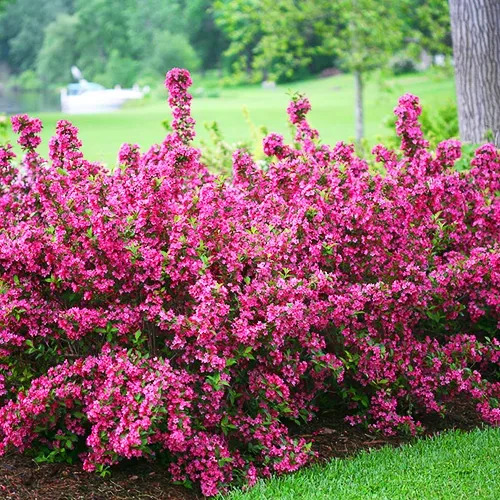Plant Pink Weigela In your Garden
Pink Weigela or Weigela florida, a decorative shrub variety, boasts a centuries-old history filled with significant developments. The plant originated in eastern Asia, especially China, Korea, and Japan, before European botanists documented it during the 18th century. Renowned botanist Carl Peter Thunberg discovered the plant during his travels in Japan in the late 1700s while noting its unique flowering habit and durability.
Throughout the 19th century European botanical gardens and royal estates embraced Florida as a treasured ornamental shrub. Horticulturists from the Victorian era highly valued this plant because of its vivid trumpet-like flowers and elegant sweeping branches. The plant became widely grown throughout England, France, and Germany during the mid-1800s before reaching North American gardens where it continues to hold a cherished place.
Pink Weigela Medicinal Uses Throughout History
The florida gained fame for its aesthetic value but also served as a subject for experimentation by ancient herbalists and traditional healers who studied its properties. Traditional medicine practitioners across Asia utilized different plant parts as treatments for minor health issues. People brewed the leaves and bark into teas or created poultices from them which were believed to treat skin irritations and minor wounds.
Traditional healers proposed that plant extracts might help treat mild inflammatory conditions, but these applications have never achieved broad medical validation. The plant's historical use in folk medicine remains noteworthy even though its decorative value now overshadows its medicinal applications.
Discovery and First Recorded Uses
Pink Weigela became known to European explorers during their documentation of East Asian plant life in the late 18th century. The Japanese botanical studies of Carl Peter Thunberg and Philipp Franz von Siebold led to the introduction of this plant to Western horticulturists.
The plant became a widespread element of European botanical collections in the early 19th century because its distinctive blooms and ability to grow in temperate regions appealed to horticulturists. Because the plant could grow in multiple soil types while producing extended-lasting flowers it became highly desirable for gardens of nobility and royalty. By the later 1800s American nurseries started selling florida plants to both homeowners and landscaping professionals which cemented their status as essential garden plants.
A Stunning Addition to Landscapes
The florida stands out among plants due to its exceptional aesthetic value and functional adaptability. The plant displays elegance and romance through its curved branches covered with pink funnel-shaped flower clusters. The plant blooms during late spring to early summer but some varieties display flowering events throughout the warmer months.
The capability of this plant to fulfill several functions makes it a common choice for garden designers who integrate it into landscape designs. As a specimen plant it creates a remarkable visual impact with its abundant flowers while its thick foliage structure makes it ideal for informal hedges or borders.
Pink Weigela stands out as a necessary selection for pollinator-friendly garden designs because it supplies nectar to both hummingbirds and bees. This plant flourishes in mixed perennial beds where its blooms provide a striking contrast with deep green leaves while pairing well with other flowering shrubs. A number of gardeners employ it to serve as a background for seasonal bulbs while others place it near pathways and garden structures to create visual interest.
Pink Weigela Captivating Beauty and Features
Florida's main feature includes its plentiful trumpet-shaped blooms which show color variations from pale pink to rich magenta. Clusters of blossoms develop along bending stems to create a flowing effect which brings both movement and grace to any landscape design.
The plant exhibits attractive foliage which consists of deep green ovate leaves that create a lush background for its vibrant flowers. Certain cultivars feature leaves with variegated patterns or burgundy coloring which enhance their decorative appeal. During autumn the plant's leaves transform into golden or reddish colors which extends their seasonal attractiveness.

The florida grows to a height and width of 4 to 6 feet which makes it a suitable size for most landscapes. The plant requires only occasional pruning to shape its form and take away spent flowers which makes it ideal for gardeners at any experience level.
Rare Wildlife It Attracts
Gardens that support pollinators benefit greatly from the florida which attracts numerous interesting wildlife species. The plant's tubular flowers attract hummingbirds who feed on its nectar-rich blooms while they hover gracefully.
The plant attracts various bee and butterfly species alongside hummingbirds which makes it ideal for gardeners who want to support local pollinators. Gardens with this plant host evening visits from specific moth species which boost local biodiversity.
The dense branches of the shrub provide shelter to small songbirds who use it as a place to rest or build their nests. The florida lacks fruit and seeds for bird sustenance but creates a balanced garden environment that supports insects which feed insect-eating bird species.
Pink Weigela A Timeless Garden Treasure
Its continuous popularity proves its beauty and versatility while remaining easy to maintain. This plant originated from East Asian landscapes and has become a prominent feature in European and North American gardens while maintaining the admiration of horticulturists and plant enthusiasts for many centuries. Gardeners who prioritize aesthetic appeal and environmental benefits will find it valuable as both a standout feature and part of hedgerow plantings or pollinator-friendly designs.
Pink Weigela stands out as one of today's most magical ornamental shrubs because of its stunning flowers and its capability to adapt while drawing rare wildlife.